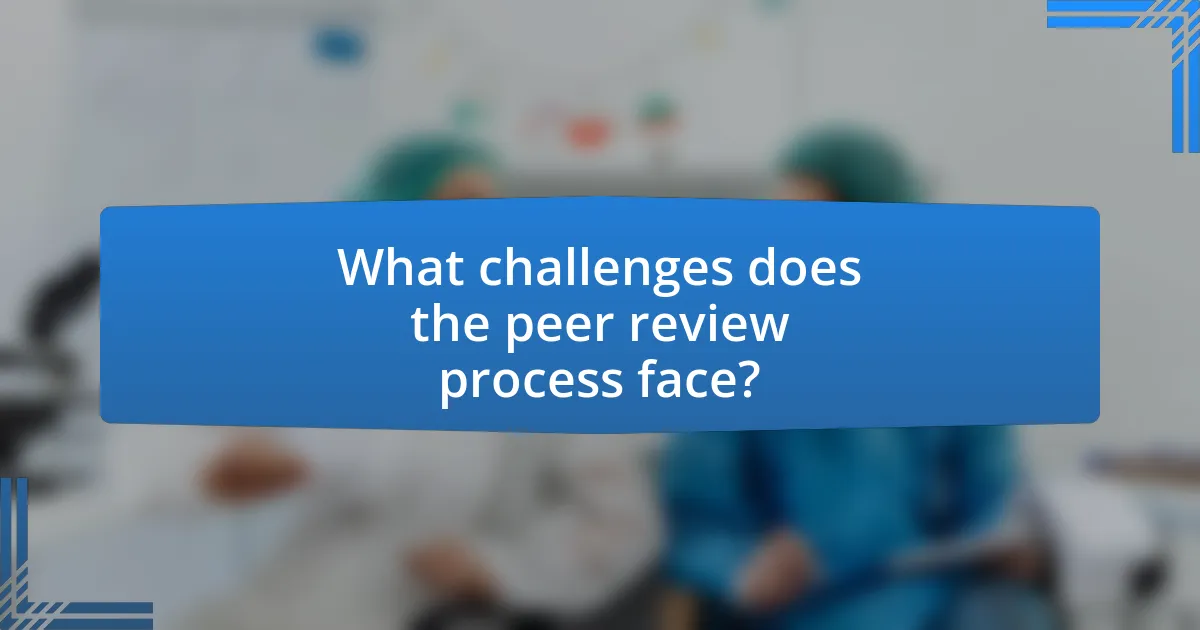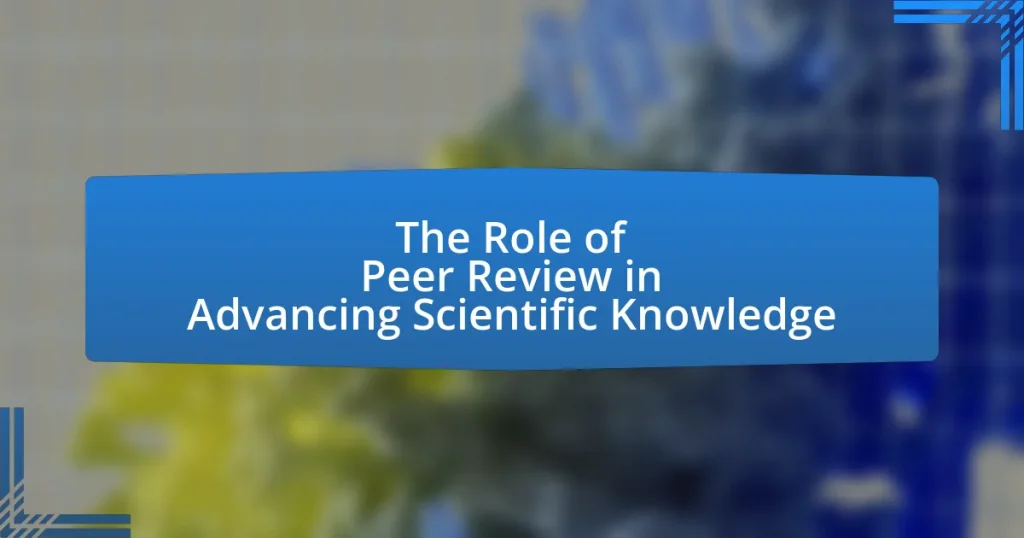Peer review is a fundamental process in scientific research that ensures the quality, validity, and reliability of published studies. This article examines the peer review process, detailing its stages, participants, and significance in enhancing research credibility. It also addresses the challenges faced by peer review, including biases and inefficiencies, and explores innovative models and best practices for improvement. By highlighting the essential role of peer review in advancing scientific knowledge, the article underscores its impact on the integrity of scientific literature and the collaborative nature of research.

What is the Role of Peer Review in Advancing Scientific Knowledge?
Peer review plays a critical role in advancing scientific knowledge by ensuring the quality, validity, and reliability of research before publication. This process involves experts in the field evaluating a study’s methodology, data analysis, and conclusions, which helps to identify any flaws or biases. According to a study published in the journal “Nature,” peer-reviewed articles are more likely to be cited and have a greater impact on subsequent research, demonstrating the effectiveness of this process in maintaining high standards in scientific literature. Furthermore, peer review fosters collaboration and dialogue among researchers, contributing to the overall growth and refinement of scientific understanding.
How does the peer review process function?
The peer review process functions as a critical evaluation mechanism for scholarly work, where experts in the relevant field assess the quality, validity, and originality of a manuscript before publication. Initially, an author submits a manuscript to a journal, which then assigns it to reviewers who are knowledgeable about the subject matter. These reviewers analyze the research methodology, results, and conclusions, providing feedback and recommendations for improvement. The journal editor considers the reviewers’ comments and decides whether to accept, reject, or request revisions to the manuscript. This process ensures that published research meets established standards of quality and contributes meaningfully to the scientific community, as evidenced by studies showing that peer-reviewed articles are more likely to be cited and have a greater impact on advancing knowledge.
What are the key stages of the peer review process?
The key stages of the peer review process include submission, initial editorial assessment, peer review, editorial decision, and publication. In the submission stage, authors submit their manuscript to a journal. The initial editorial assessment involves the editor evaluating the manuscript for suitability and quality. During the peer review stage, experts in the field review the manuscript, providing feedback and recommendations. The editorial decision stage follows, where the editor makes a decision based on the reviewers’ comments, which can lead to acceptance, revision, or rejection. Finally, if accepted, the manuscript proceeds to publication. Each stage is critical for ensuring the integrity and quality of scientific research.
Who are the participants involved in peer review?
The participants involved in peer review are typically authors, reviewers, and editors. Authors submit their research manuscripts for evaluation, while reviewers, who are experts in the relevant field, assess the quality, validity, and significance of the work. Editors oversee the peer review process, making decisions on publication based on the reviewers’ feedback and ensuring that the review is conducted fairly and efficiently. This structured interaction among these participants is essential for maintaining the integrity and quality of scientific literature.
Why is peer review considered essential in scientific research?
Peer review is considered essential in scientific research because it ensures the quality and credibility of published work. This process involves experts evaluating research for its validity, significance, and originality before publication, which helps to identify errors, biases, and methodological flaws. Studies have shown that peer-reviewed articles are more likely to be reliable and influential, as they undergo rigorous scrutiny that enhances the overall integrity of scientific literature. For instance, a 2018 analysis published in the journal “PLOS ONE” found that peer-reviewed studies had a higher citation impact compared to non-peer-reviewed works, underscoring the importance of this process in advancing scientific knowledge.
What are the main benefits of peer review for researchers?
The main benefits of peer review for researchers include improved research quality, enhanced credibility, and constructive feedback. Peer review ensures that research is rigorously evaluated by experts in the field, which helps identify flaws and strengthens the overall quality of the work. This process increases the credibility of the research, as publications that undergo peer review are often viewed as more trustworthy by the scientific community and the public. Additionally, researchers receive constructive feedback that can guide revisions and improve their work before publication, ultimately contributing to the advancement of scientific knowledge.
How does peer review enhance the credibility of scientific findings?
Peer review enhances the credibility of scientific findings by subjecting research to evaluation by experts in the field before publication. This process ensures that the methodology, data analysis, and conclusions are scrutinized for accuracy and validity. Studies have shown that peer-reviewed articles are more likely to be reliable, as they undergo rigorous checks for quality and adherence to scientific standards. For instance, a 2018 analysis published in the journal “PLOS ONE” found that peer-reviewed studies had a significantly lower rate of retraction compared to non-peer-reviewed work, indicating a higher level of trust in the findings.

What challenges does the peer review process face?
The peer review process faces several significant challenges, including bias, lack of transparency, and inefficiency. Bias can manifest in various forms, such as gender bias or favoritism towards certain institutions, which can skew the evaluation of research quality. Lack of transparency often leads to questions about the integrity of the review process, as reviewers may remain anonymous, making it difficult to hold them accountable. Additionally, inefficiency is a major concern, with studies indicating that the average time for peer review can exceed six months, delaying the dissemination of important scientific findings. These challenges undermine the credibility and effectiveness of peer review in advancing scientific knowledge.
How do biases affect peer review outcomes?
Biases significantly affect peer review outcomes by influencing the evaluation process, leading to potential favoritism or discrimination against certain authors or ideas. For instance, studies have shown that gender bias can result in female authors receiving lower scores compared to male authors for similar quality submissions, as evidenced by a 2018 analysis published in the journal “Nature”. Additionally, biases related to institutional affiliation can skew reviewers’ perceptions, favoring work from prestigious institutions over equally valid research from lesser-known entities. These biases can ultimately compromise the integrity of the peer review process, affecting the quality and diversity of published scientific knowledge.
What types of biases are commonly observed in peer review?
Common biases observed in peer review include confirmation bias, gender bias, and publication bias. Confirmation bias occurs when reviewers favor studies that support their own beliefs or hypotheses, potentially leading to unfair evaluations. Gender bias manifests when reviewers exhibit preferences based on the author’s gender, often disadvantaging female researchers. Publication bias arises when studies with positive results are more likely to be published than those with negative or inconclusive findings, skewing the overall scientific literature. These biases can significantly impact the integrity and fairness of the peer review process, ultimately affecting the advancement of scientific knowledge.
How can biases be mitigated in the peer review process?
Biases in the peer review process can be mitigated by implementing double-blind reviews, where both reviewers and authors remain anonymous, reducing the influence of personal biases. Additionally, establishing clear guidelines for reviewers can help standardize evaluations and minimize subjective judgments. Research indicates that double-blind peer review can lead to more equitable treatment of submissions, as shown in a study published in the journal “Nature” by Budden et al. (2008), which found that gender bias was reduced when authors’ identities were concealed. Furthermore, diversifying the pool of reviewers can enhance perspectives and reduce systemic biases, as a varied group is less likely to share the same prejudices.
What are the limitations of the current peer review system?
The current peer review system has several limitations, including bias, lack of transparency, and inefficiency. Bias can occur when reviewers favor certain methodologies or perspectives, potentially leading to the exclusion of valuable research. A study published in “Nature” by Lee et al. (2013) found that reviewers’ biases can significantly affect publication outcomes. Lack of transparency is another issue, as the anonymity of reviewers can lead to unaccountable decisions and hinder constructive feedback. Additionally, the peer review process can be inefficient, often taking months or even years, which delays the dissemination of important findings. According to a report by the National Academy of Sciences (2015), this inefficiency can stifle innovation and slow the advancement of scientific knowledge.
How does the speed of peer review impact scientific progress?
The speed of peer review significantly impacts scientific progress by influencing the timely dissemination of research findings. Faster peer review processes allow researchers to share their results more quickly, facilitating collaboration and the advancement of knowledge. For instance, a study published in the journal “Nature” found that expedited peer review can reduce the time from submission to publication by up to 50%, enabling scientists to build on each other’s work more rapidly. This acceleration can lead to quicker innovations and responses to emerging scientific challenges, such as public health crises. Therefore, the efficiency of peer review directly correlates with the pace at which scientific advancements occur.
What are the criticisms regarding transparency in peer review?
Criticisms regarding transparency in peer review include concerns about the lack of openness in the review process, which can lead to biases and conflicts of interest. Many argue that anonymous reviews can shield reviewers from accountability, potentially allowing for unconstructive criticism or favoritism. Additionally, the absence of clear guidelines on how reviews are conducted can result in inconsistencies in evaluation standards. Research published in the journal “Nature” highlights that only 30% of researchers believe that peer review is transparent, indicating widespread skepticism about the integrity of the process.

How can peer review be improved to better advance scientific knowledge?
Peer review can be improved to better advance scientific knowledge by implementing more transparent and inclusive processes. Transparency can be enhanced by making peer review reports publicly accessible, allowing for broader scrutiny and fostering accountability among reviewers. Inclusivity can be achieved by diversifying the pool of reviewers to include underrepresented voices and perspectives, which can lead to more comprehensive evaluations. Research indicates that diverse teams produce more innovative solutions, as shown in a study published in the Proceedings of the National Academy of Sciences, which found that diversity in scientific teams leads to higher impact research. By adopting these strategies, the peer review process can become more effective in promoting rigorous and equitable scientific discourse.
What innovative models are emerging in peer review?
Innovative models emerging in peer review include open peer review, collaborative peer review, and post-publication peer review. Open peer review allows for transparency by making reviewer comments and author responses publicly accessible, fostering accountability and constructive feedback. Collaborative peer review involves multiple reviewers working together, enhancing the quality of feedback and reducing biases. Post-publication peer review permits ongoing evaluation of research after publication, enabling continuous improvement and engagement from the broader scientific community. These models aim to increase transparency, improve the quality of reviews, and adapt to the evolving landscape of scientific communication.
How does open peer review differ from traditional peer review?
Open peer review differs from traditional peer review primarily in transparency and accessibility. In open peer review, the identities of both the reviewers and authors are disclosed, and the review process is often published alongside the final article, allowing for greater accountability and collaboration. Traditional peer review, on the other hand, typically maintains anonymity for reviewers, which can lead to biases and less constructive feedback. Studies have shown that open peer review can enhance the quality of reviews and increase the trust in published research, as evidenced by a 2017 analysis in the journal “Nature” that highlighted improved reviewer engagement and more thorough evaluations in open systems.
What role do technology and automation play in enhancing peer review?
Technology and automation significantly enhance peer review by streamlining the submission, review, and publication processes. Automated systems facilitate the matching of manuscripts with appropriate reviewers based on expertise, reducing the time taken to find qualified individuals. For instance, platforms like ScholarOne and Editorial Manager utilize algorithms to optimize reviewer selection, which can lead to faster turnaround times and improved quality of reviews. Additionally, technology enables the use of plagiarism detection software, ensuring the integrity of submissions and maintaining high academic standards. Studies indicate that journals employing these technologies experience a reduction in review times by up to 30%, thereby accelerating the dissemination of scientific knowledge.
What best practices can researchers adopt for effective peer review?
Researchers can adopt several best practices for effective peer review, including providing constructive feedback, adhering to deadlines, and maintaining confidentiality. Constructive feedback helps authors improve their work by offering specific suggestions for enhancement, which is essential for the advancement of scientific knowledge. Adhering to deadlines ensures a timely review process, which is critical for maintaining the integrity and efficiency of academic publishing. Maintaining confidentiality protects the integrity of the review process and fosters trust among researchers. These practices are supported by guidelines from organizations such as the Committee on Publication Ethics, which emphasizes the importance of ethical standards in peer review.
How can researchers select appropriate reviewers for their work?
Researchers can select appropriate reviewers for their work by identifying experts in their specific field who have relevant experience and knowledge. This can be achieved by reviewing recent publications in the same area, utilizing databases like Scopus or Web of Science to find authors with similar research interests, and considering individuals who have previously published on related topics. Additionally, researchers should ensure that potential reviewers have no conflicts of interest, such as personal or professional relationships that could bias their evaluation. This method is supported by the practice of many journals that emphasize the importance of selecting unbiased and knowledgeable reviewers to maintain the integrity of the peer review process.
What strategies can be employed to respond to peer review feedback constructively?
To respond to peer review feedback constructively, researchers should adopt strategies such as actively acknowledging the feedback, addressing each comment systematically, and providing clear explanations for any disagreements. Acknowledging feedback demonstrates respect for the reviewers’ insights, while systematically addressing comments ensures that all concerns are considered, which can enhance the quality of the research. Providing clear explanations for disagreements allows for constructive dialogue and can lead to improved understanding of the research context. These strategies are supported by studies indicating that constructive engagement with peer feedback leads to higher acceptance rates in academic publishing, as seen in the research by Lee et al. (2019) in the journal “Research Evaluation,” which highlights the importance of addressing reviewer comments thoroughly to improve manuscript quality.


